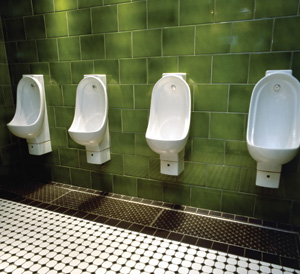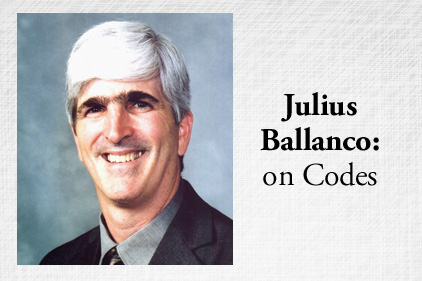
|
|
The International Code Council will discuss many energy- and water-conservation code changes during the ICC’s April 27-May 3 meeting in Memphis, Tenn. Photo credit: ©istockphoto.com/mikdam |
This year, the International Code Council enters into its Group C code-change cycle. This cycle means “green.” ICC has published the proposed changes to the International Green Construction Code. For more on those changes, see pme’s Departments section (Kristin-add link to Departments).
ICC also has announced that the 2015 codes, other than the green code, will be published in June 2014. The concept of the single cycle for each code is to allow the ICC to have the codes available for review before the official year of publication.
The ICC also announced that it is tinkering with the groups for proposing code changes. The IRC plumbing and IRC mechanical changes were moved to Group A from Group B. This means all plumbing- and mechanical-related changes will be heard in the first group of changes and would include the IPC, IMC, IRC Plumbing and IRC Mechanical. Also included in Group A is the Fuel Gas Code.
You have until Jan. 12, 2015 to propose a change to the IRC plumbing or mechanical section. It’s the last opportunity to propose a change to the 2018 code.
The IGCC, also known as the green code, has two groups of proposed changes. The first group includes the general requirements. The second group covers the energy and water conservation requirements. As engineers, we tend to look at energy and water conservation requirements while somewhat ignoring the general requirements. I would encourage you to peruse the changes proposed to the general requirements. These changes attempt to define what is green in the ICC.
For example, the code currently prohibits unvented gas-fired fireplaces apparently because of health concerns. However, the code does allow unvented kitchen stoves. There are a series of proposed changes to permit unvented gas fireplaces.
Some other related interesting general proposed changes include a requirement for radon testing and another requirement for indoor air-quality testing.
Plenty of ground to cover
There are 188 proposed changes regarding energy and water conservation. Many changes delete sections that have been added to the main codes, such as the Plumbing Code or Mechanical Code. The IGCC only intends to address areas that are not covered in the other codes.
Many changes are proposed to tighten up efficiency requirements for appliances. That is to be expected for a green code. Some green advocates are of the opinion that an appliance should generate energy by using a renewable source. Simply translated, that means an efficiency of greater than 100.
One change proposes the prohibition of using No. 4 or No. 6 fuel oil. I find this interesting because I remember an argument I had with a building engineer on an East Coast project. The engineer insisted that the multi-fuel boiler I was specifying also burn No. 6 fuel oil. I refused to add it as one of the fuels and the argument ended up before the building owner. I won, but that building engineer never forgave me and he still believes burning No. 6 fuel oil is efficient.
Currently, the IGCC requires waste heat recovery systems for certain buildings. There are a number of changes proposed to modify these requirements. There also is a proposal to mandate compliance to a specific standard for determining waste heat recovery efficiency.
What would a green code be without many proposed changes to the water conservation flow rates? However, it is somewhat surprising that none of the changes involve the water-closet flush volume. The same cannot be said for urinals. One change proposes lowering the urinal flush volume from 0.5 gpf to 0.125 gpf. This change is in response to the additional number of nonwater and 0.125-gpf urinals.
The other proposed changes to the flow rate include a reduction in lavatory from 1.5 gpm to 1-gpm. For a shower, the rates are proposed to be lowered from 2 gpm to 1.75 gpm and kitchen sinks would be lowered from 2.2 gpm to 2-gpm.
Fill ’er up
Drinking fountains also are addressed in the proposed changes. One proposal would require every drinking fountain to be a capable water bottle filling station. This could be accomplished by a high-arcing stream of water or by a built-in bottle filler. Another change would allow bottle-filling stations to be substituted for half of the drinking fountains.
The most interesting change would require emergency water in the event of a power failure. The change would require residential and institutional buildings to have a water supply on the lower floors supplied by the public main without any pumping. This would allow water during a blackout. This change is really geared toward high-rise buildings.
Some engineers prefer to have the lower floors supplied by the pressure in the street and only pump to the higher floors requiring a boost in pressure. Other engineers prefer to pump to the entire building. While the concept is interesting and has merit, it is difficult to understand how such a requirement is green. I am sure there will be testimony that the emergency drinking water is still in the piping even if the pumps are off.
The final water conservation proposal is for food-waste disposers and pulpers. Disposers would be limited to 8 gpm, while pulpers would be limited to 2 gpm. In addition, both devices would be required to have run-cycle time-limiting devices that would allow a maximum cycle time of 10 minutes.
Another change that appears surprising is the proposed removal of all the graywater, rainwater and reclaimed water requirements. At first you would think the proponent is crazy. However, all these requirements were added to the 2015 International Plumbing Code. Once they appear in the main code, they are no longer needed in the green code.
The first hearings for the green code will take place April 27-May 3 in Memphis, Tenn. The plumbing and mechanical sections are scheduled for the end of the hearing beginning April 30.
If you cannot attend the hearings, you always can watch them live on the ICC broadcast. The new system is supposed to be set up so you can watch the hearings on the ICC’s CDPaccess even after they close. It is worth registering with CDPaccess. It will give you great insight into the code-change process.


